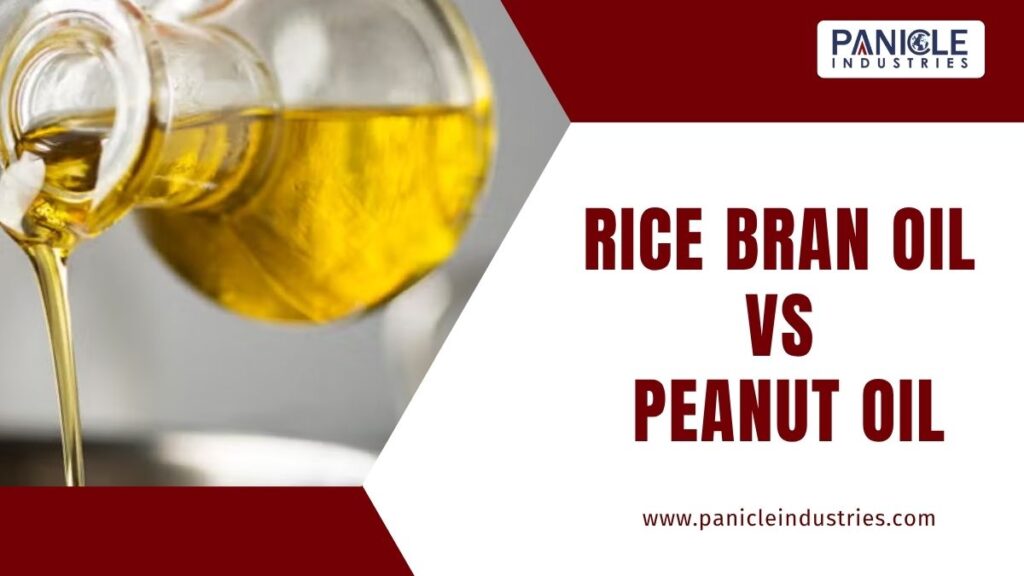Choosing the right cooking oil is important for maintaining good health and improving the taste of your food. With so many options available today, many people wonder about the differences between rice bran oil vs peanut oil. Both oils are commonly used in Indian and Asian kitchens and are known for their high smoke points, making them suitable for deep frying and sautéing. While rice bran oil is made from the outer layer of rice grains, peanut oil is made from pressed peanuts. Each oil has its own benefits, flavor, and nutritional value.
In this blog, we will compare rice bran oil and peanut oil based on their origin, health benefits, cooking uses, and more to help you decide which one suits your needs best.
What Is Rice Bran Oil?
Rice bran oil is extracted from the bran, which is the outer layer of the rice grain. This layer is usually removed during the milling of white rice. Though often considered a by-product, this part of the rice is rich in healthy fats, antioxidants, and nutrients.
Key Features:
- Light in texture
- Mild, neutral flavor
- High in antioxidants like gamma-oryzanol
- Suitable for high-heat cooking due to high smoke point (~450°F or 232°C)
It is especially popular in Asian countries like Japan, India, and China for both home and commercial cooking.
Also read: What is Rice Bran Oil Made of
What Is Peanut Oil?
Peanut oil, also known as groundnut oil, is extracted from peanuts, which are legumes. This oil is also widely used in Asian, African, and American cooking.
Key Features:
- Slightly nutty flavor
- Golden color
- High in monounsaturated fats
- High smoke point (~450°F or 232°C)
There are several types of peanut oil: refined, cold-pressed, roasted, and gourmet. Each has its own specific use in cooking and flavor profile.
Rice Bran Oil vs Peanut Oil: A Nutritional Comparison
Let’s take a look at the nutritional values of both oils per 1 tablespoon (13.6g):
| Nutrient | Rice Bran Oil | Peanut Oil |
|---|---|---|
| Calories | 120 | 120 |
| Total Fat | 14g | 14g |
| Saturated Fat | 2.7g | 2.3g |
| Monounsaturated Fat | 5.4g | 6.2g |
| Polyunsaturated Fat | 5g | 4.3g |
| Vitamin E | High | Moderate |
| Omega-6 | Yes | Yes |
| Omega-3 | Very Low | Very Low |
Summary:
- Both oils are similar in calories and fat content
- Rice bran oil is slightly richer in antioxidants
- Peanut oil has more monounsaturated fats, which are heart-healthy
Health Benefits of Rice Bran Oil
1. Heart Health
Rich in oryzanol and unsaturated fats, rice bran oil helps lower LDL (bad cholesterol) while keeping HDL (good cholesterol) stable.
2. Rich in Antioxidants
Compounds like gamma-oryzanol and tocopherols help fight free radicals and reduce oxidative stress.
3. Skin-Friendly
Used in skincare due to its light texture and moisturizing properties.
4. Good for Diabetics
Some studies suggest it may help control blood sugar levels.
Health Benefits of Peanut Oil
1. Cardiovascular Health
Peanut oil contains monounsaturated fats which support heart health by lowering bad cholesterol levels.
2. Anti-inflammatory Properties
It contains plant sterols and resveratrol, which may help reduce inflammation.
3. Rich in Vitamin E
Acts as an antioxidant that protects cells and improves skin health.
4. Energy Booster
Good source of healthy fats that can help provide sustained energy.
Cooking with Rice Bran Oil
Rice bran oil is excellent for high-heat cooking due to its high smoke point. It doesn’t change flavor when heated, which makes it ideal for:
- Deep frying
- Stir-frying
- Sautéing
- Baking
- Salad dressings (when cold-pressed)
Best Dishes:
- Indian curries
- Stir-fried vegetables
- Fried snacks like samosas and pakoras
- Rice dishes like biryani
Cooking with Peanut Oil
Peanut oil also has a high smoke point and brings a mild nutty flavor to your food. It works well in:
- Frying
- Roasting
- Stir-frying
- Grilling
Best Dishes:
- Chinese stir-fried noodles
- Southern fried chicken
- Thai peanut sauces
- Roasted vegetables
Taste and Aroma
| Feature | Rice Bran Oil | Peanut Oil |
|---|---|---|
| Flavor | Mild and neutral | Slightly nutty |
| Aroma | Very light | Distinct peanut aroma |
| Best For | Dishes where you don’t want the oil to affect flavor | Dishes where a nutty taste enhances the dish |
If you’re cooking something delicate, like lightly spiced rice or dal, rice bran oil is ideal. For recipes that benefit from a nutty flavor, such as stir-fries or peanut sauces, peanut oil is a better fit.
Allergies and Safety
Rice Bran Oil:
- Safe for most people
- Usually hypoallergenic
- Free from common allergens like nuts, soy, or dairy
Peanut Oil:
- May trigger allergies
- Even refined peanut oil can cause reactions in people with severe peanut allergies
- Cold-pressed or gourmet peanut oil is more likely to contain allergens
Note: Always consult a doctor if you’re unsure about food allergies.
Price and Availability
| Factor | Rice Bran Oil | Peanut Oil |
|---|---|---|
| Cost | Moderate | Slightly lower |
| Availability | Common in India and Asia | Widely available worldwide |
| Shelf Life | 6–12 months | 6–12 months |
Both oils are affordable and widely available. Rice bran oil is more common in Indian markets, while peanut oil is widely found in American and Chinese markets.
Which Oil Should You Choose?
Here’s a simple guide to help you decide:
Choose Rice Bran Oil if:
- You want a neutral-flavored oil
- You cook at high temperatures (deep frying, stir-frying)
- You have nut allergies
- You want more antioxidants in your oil
Choose Peanut Oil if:
- You enjoy a light, nutty flavor
- You frequently cook Asian dishes
- You prefer high monounsaturated fat content
- You do not have a peanut allergy
Environmental Consideration
Rice bran oil is made from a byproduct of rice milling, making it a more sustainable choice. Peanut farming, while effective, may use more water and land. From an environmental point of view, rice bran oil could have a smaller ecological footprint.
Conclusion
When it comes to rice bran oil vs peanut oil, both are excellent choices for everyday cooking. Each has a high smoke point, making them suitable for frying and sautéing. Rice bran oil is rich in antioxidants and offers a mild flavor, while peanut oil adds a nutty taste and is high in heart-healthy fats. Your final choice depends on your taste preferences, cooking style, and any dietary restrictions, such as allergies. If you’re looking for a neutral and healthy oil, rice bran oil may be the right fit. If you enjoy a richer, nutty flavor, peanut oil is ideal. Choose wisely and enjoy cooking healthier meals every day.


